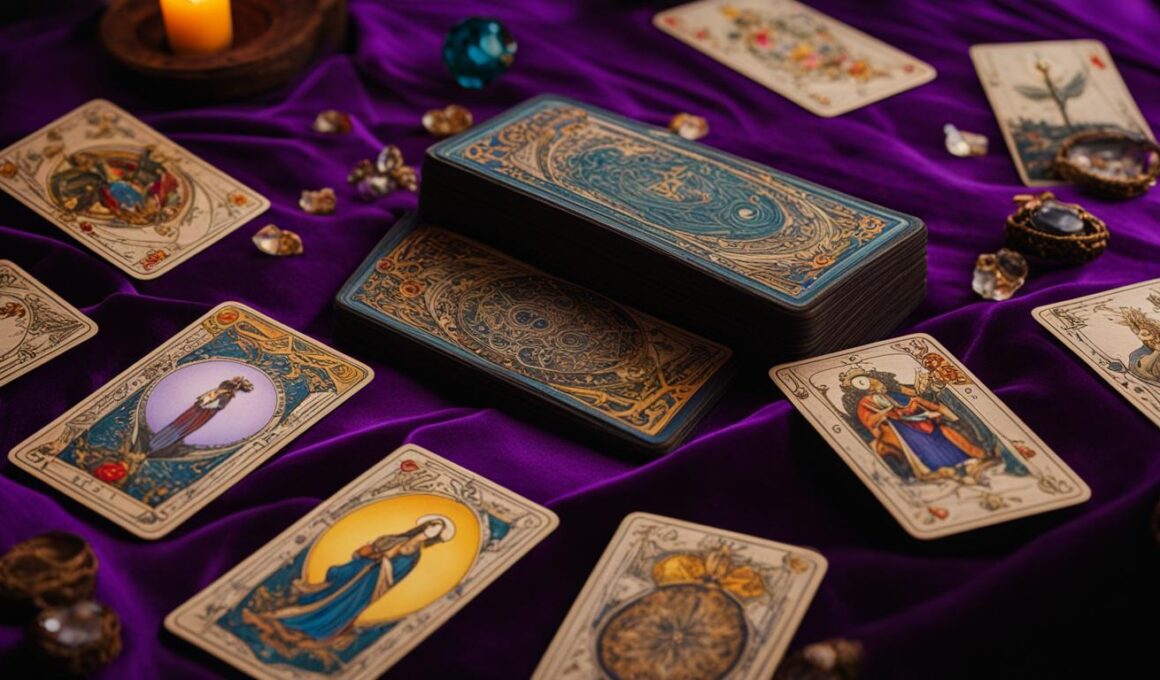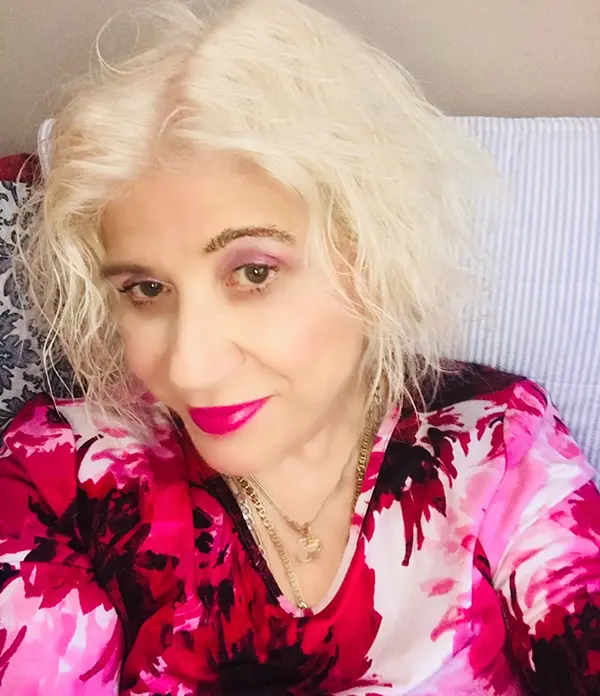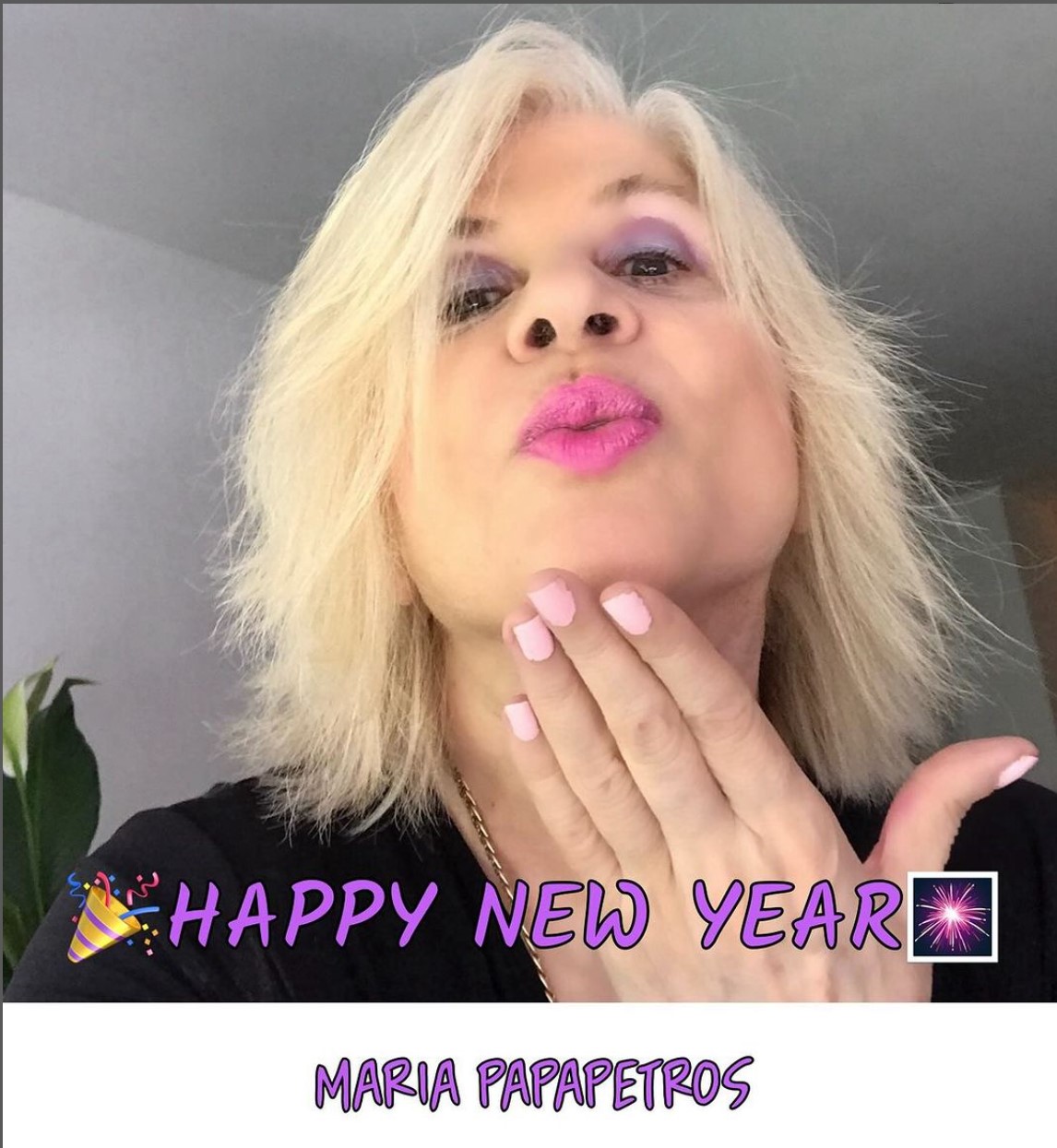Welcome to our beginner’s guide to tarot card reading! If you’ve ever been intrigued by the mystical world of tarot cards and want to learn how to tap into their wisdom and guidance, you’re in the right place. In this guide, we will take you through the basics of tarot card reading, unraveling the meanings behind the cards and providing you with the tools to read them effectively.
Key Takeaways:
- Get a comprehensive introduction to tarot card reading.
- Understand the basics of tarot card meanings and how to read them.
- Explore the fascinating history and artistry of tarot cards.
- Discover the major and minor arcana and their significance.
- Find the perfect tarot card deck that resonates with you.
A Historical Overview and Artistry of Tarot Cards
In this section, we will delve into the fascinating history and artistic beauty of tarot cards. Tarot cards have a long and intriguing historical background that dates back to the mid-15th century. Originally used as playing cards in Northern Italy, they eventually evolved to become associated with divination and spiritual practices.
The Origins and Evolution of Tarot
The origins of tarot cards can be traced back to Italy in the 15th century. While the exact origins are unclear, it is believed that tarot cards were derived from a combination of card games played in Europe at the time, such as the Italian tarocchini and the French tarot. Initially, the cards were used for entertainment purposes and played a role in social gatherings.
However, over time, tarot cards gained a deeper meaning and became linked to various esoteric practices, including divination and fortune-telling. The cards were believed to hold mystical and symbolic significance, with each card representing unique concepts, archetypes, and spiritual lessons.
As tarot cards grew in popularity, different regions developed their own versions of the deck, resulting in various artistic styles and interpretations. The imagery and symbolism found in tarot cards became deeply ingrained in Western culture, with countless artists contributing to the rich tapestry of tarot artwork throughout history.
Symbolism and Significance in Tarot Artwork
One of the most captivating aspects of tarot cards is the intricate artwork that adorns each card. The symbolism and imagery depicted in tarot cards carry immense significance and provide layers of meaning for readers and enthusiasts.
The artwork on tarot cards often draws inspiration from diverse sources, including mythology, alchemy, astrology, and religious and spiritual traditions. Each card is meticulously crafted to convey specific messages and evoke particular emotions or insights.
The symbols and imagery found in tarot cards are intended to stimulate the subconscious mind and tap into our collective unconsciousness. They can evoke deep emotions, trigger personal introspection, and spark intuitive insights. By working with the imagery and symbolism of tarot cards, readers can uncover hidden truths, gain clarity, and access the wisdom of their higher selves.
Additionally, the artistic style and aesthetic of tarot cards vary across different decks. From the traditional Rider-Waite-Smith deck to contemporary and abstract interpretations, each deck offers a unique visual language that enhances the reading experience and allows for personal connections and interpretations.
To give you a visual representation of the artistic beauty of tarot cards, take a moment to admire this stunning tarot artwork:
| Deck | Artist | Artistic Style |
|---|---|---|
| 1. Rider-Waite-Smith | Pamela Colman Smith | Traditional and symbolic |
| 2. Thoth Tarot | Aleister Crowley and Lady Frieda Harris | Mystical and occult |
| 3. Wild Unknown Tarot | Kim Krans | Minimalist and intuitive |
| 4. Tarot of Marseille | Various artists | Classic and traditional |
The table above showcases a few examples of notable tarot decks, their respective artists, and their unique artistic styles. These decks exemplify the diverse range of artistic expression and creativity that exists within the world of tarot.
By exploring the historical origins and artistic significance of tarot cards, we can deepen our appreciation for this ancient practice and cultivate a greater understanding of the profound wisdom that lies within each card.
Introduction to Tarot Card Reading
In this section, we will provide a comprehensive introduction to tarot card reading. Tarot card reading is a practice that has been used for centuries to gain insight and guidance into various aspects of life. By understanding the basics of tarot card reading, you can tap into the wisdom and symbolism of the cards to explore the past, present, and future.
How Tarot Cards Work: Tarot cards are a tool used to tap into our intuition and the collective unconscious. Each card in the deck holds specific meanings and symbolism that can be interpreted to provide guidance on different areas of life, such as relationships, career, and personal growth.
The Tarot Deck: A standard tarot deck consists of 78 cards, divided into two main groups: the Major Arcana and the Minor Arcana. The Major Arcana cards represent major life themes and transitions, while the Minor Arcana cards focus on everyday aspects of life. Each card carries its own unique energy and meaning.
Understanding Tarot Card Meanings: To begin reading tarot cards, it is essential to familiarize yourself with the meanings of each card in the deck. While there are many resources available that provide interpretations, it is important to develop your own connection with the cards and trust your intuition when interpreting their messages.
Remember, tarot card reading is a personal practice and there is no one right way to interpret the cards. It is a journey of self-discovery and intuition, allowing you to tap into your inner wisdom and connect with the energies around you.
By the end of this section, you will have a solid foundation in tarot card reading, understanding the basics of how tarot cards work, the different types of cards in a tarot deck, and their meanings. This knowledge will empower you to delve deeper into the world of tarot, unlocking its insights and guidance for your own personal growth and spiritual journey.
Understanding the Major and Minor Arcana
The tarot deck is divided into two main parts: the Major Arcana and the Minor Arcana. The Major Arcana consists of 22 cards, each representing a significant life theme and journey. These cards hold deep symbolism and offer insights into the major events and lessons in our lives. The Minor Arcana, on the other hand, consists of 56 cards divided into four suits: Cups, Pentacles, Swords, and Wands. These cards focus more on the day-to-day aspects of our lives, offering guidance on relationships, work, emotions, and spirituality.
Each card in the Major and Minor Arcana has its own unique meaning and interpretation. Understanding the tarot card meanings is essential for accurate and insightful readings. The Major Arcana cards represent archetypal energies and universal themes, while the Minor Arcana cards provide specific details and guidance related to our daily experiences.
By exploring the Major and Minor Arcana, readers can gain a comprehensive understanding of the rich symbolism and profound insights that tarot cards hold. This knowledge will empower individuals to unlock the wisdom within the cards and use them as a powerful tool for self-reflection, growth, and guidance.
Finding Your Tarot Card Deck and Connecting with It
Finding the right tarot card deck is an essential step in establishing a strong connection with the cards. It’s important to choose a deck that resonates with you and fits your personal style. Here are some tips to help you find the perfect tarot deck:
Choosing a Deck That Resonates with You
When selecting a tarot deck, trust your intuition and choose one that speaks to you visually and emotionally. Look for decks with artwork, themes, and symbolism that resonate with your personal interests and beliefs. Different decks have different aesthetics and energies, so explore various options and see which one captures your attention and stirs your curiosity.
Consider the following factors:
- Artwork style: Determine whether you prefer traditional, modern, or abstract artwork.
- Theme: Explore decks with themes related to nature, fantasy, mythology, or specific cultural traditions.
- Suit symbols: Pay attention to the symbols used in the deck’s suit cards (Cups, Pentacles, Swords, Wands) and choose the one that resonates with you the most.
Remember, your tarot deck should be a reflection of your personal journey and connection with the cards, so take your time in choosing one that truly resonates with you.
The Myth: Must Tarot Decks Be Gifted?
There is a common myth that a tarot deck must be gifted to you in order for it to work effectively. However, this is simply not true. While receiving a deck as a gift can have sentimental value, it is not a requirement for a tarot deck to be gifted in order for it to be accurate or meaningful in your readings.
Feel free to purchase your own tarot deck based on your preferences and connection with the cards. Remember, the energy you bring to the deck and your intention behind it are what truly matter in establishing a meaningful connection.
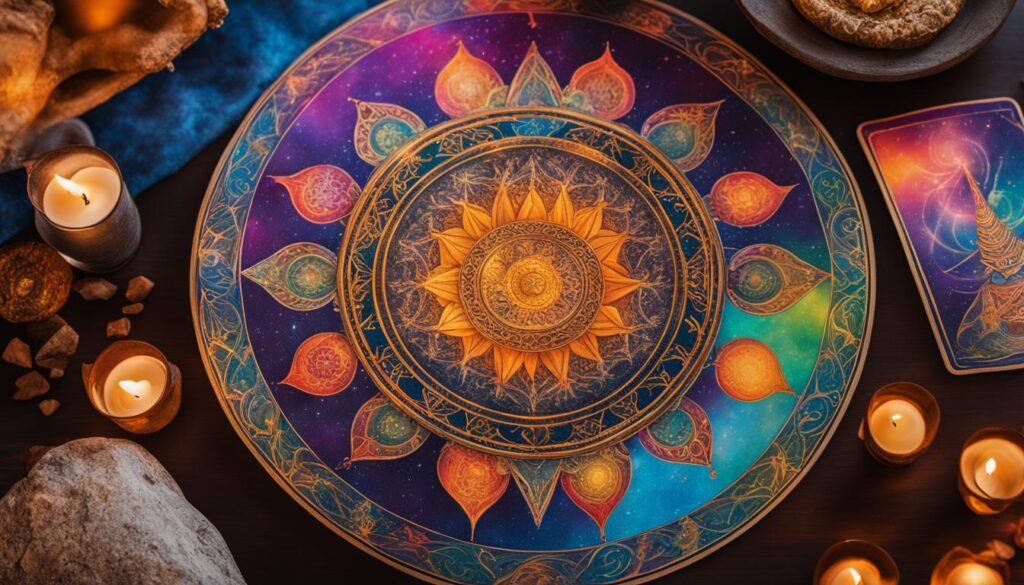
Exploring Tarot Deck Symbolism
Tarot decks often include symbols, imagery, and archetypes that hold deeper meanings. Each card has its own unique symbolism, which can enhance your interpretation and understanding of the reading. Take the time to study the symbolism present in your chosen deck and familiarize yourself with its hidden messages.
By delving into the symbolism of the cards, you’ll unlock new layers of insight and connection with the tarot. You can refer to guidebooks or online resources to help you decode the symbolism of your deck.
Remember, connecting with your tarot deck is a personal and intuitive process. Take the time to explore different decks, choose one that resonates with you, debunk the myth of gifting, and delve into the symbolism present in your chosen deck. Building a strong connection with your tarot deck will enhance your readings and allow for deeper insights.
The Importance of Setting Up Your Reading Space
Creating a dedicated and comfortable space for tarot card readings is essential for establishing a focused and intuitive mindset. When you have a designated space for your tarot practice, it allows you to immerse yourself fully in the energy of the cards and create an environment conducive to deep introspection and connection.
Here are some tips on how to create an ideal tarot reading space:
- Choose a quiet and private area: Find a secluded corner of your home where you can conduct readings without interruptions or distractions. This space should offer you a sense of privacy and tranquility.
- Clear the energy: Before you begin setting up your reading space, it’s important to cleanse the area energetically. You can do this by smudging with sage or using crystals like clear quartz or selenite to purify the space.
- Add personal touches: Make the space your own by adding meaningful objects or decorations that inspire you and enhance your connection with the tarot. This could include candles, crystals, artwork, or anything else that resonates with your spiritual practice.
- Organize your tarot deck: Keep your tarot cards neatly organized and easily accessible in your reading space. Consider using a special box, bag, or shelf to store your deck, ensuring that it is protected and respected.
- Create a comfortable seating area: Set up a comfortable chair or cushion where you can sit during your readings. Make sure that you have adequate lighting and that the seating area promotes relaxation and focus.
- Set the mood: Use soft lighting, such as candles or fairy lights, to create a calming and mystical ambiance in your reading space. You may also want to play soothing music or use aromatherapy to enhance the atmosphere.
By setting up an inviting and sacred space for your tarot card readings, you are signaling to your subconscious mind that this is a special and sacred practice. This will help you to enter a state of deep awareness and receptivity, allowing you to tap into your intuition and derive profound insights from the cards.
Learning Tarot Card Spreads
In tarot card reading, different card spreads are used to provide insights and answers to specific questions or areas of life. By understanding and utilizing tarot card spreads, you can gain a deeper understanding of the messages and guidance the cards have to offer. In this section, we will focus on two popular tarot spreads: the Celtic Cross spread and the daily card reading.
Mastering the Celtic Cross Spread
The Celtic Cross spread is one of the most well-known and widely used tarot spreads. It consists of ten cards arranged in a specific pattern, each representing different aspects of the querent’s life or situation. By mastering the Celtic Cross spread, you can gain detailed insights into past influences, current challenges, and future possibilities. This spread is particularly helpful when seeking a comprehensive and in-depth analysis of a particular question or issue.
To master the Celtic Cross spread, it is essential to have a solid understanding of each position and its significance. Each card’s placement in the spread carries specific meaning and contributes to the overall interpretation. By studying and practicing this spread, you can develop your ability to piece together the story and messages the cards are conveying.
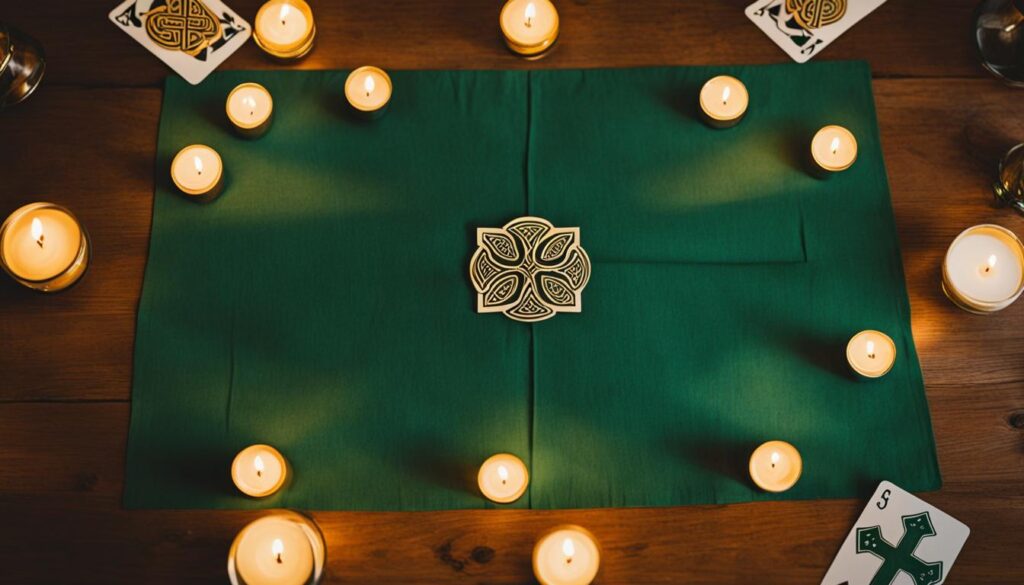
Daily Card Reading: A Habit for Intuition Development
In addition to mastering specific tarot card spreads, developing the habit of daily card reading is a powerful tool for intuition development. By drawing a daily card and reflecting on its meaning, you can enhance your intuitive abilities and deepen your connection with the tarot deck.
A daily card reading can serve as a moment of self-reflection and guidance. It provides a daily focus and allows you to tap into your intuition and inner wisdom. Over time, this practice can help you develop a stronger bond with your tarot deck and enhance your overall tarot card reading skills.
Make it a habit to draw a daily card and take a few moments to contemplate its meaning. Consider how it relates to your current situation, emotions, or challenges. Journaling about your daily card readings can also be helpful in capturing insights and patterns that arise over time.
| Key Points | |
|---|---|
| Tarot card spreads provide insights and answers to specific questions or areas of life. | Tarot card spreads |
| The Celtic Cross spread is a popular and comprehensive tarot spread. | Celtic Cross spread |
| Mastering the Celtic Cross spread requires understanding the significance of each position. | Mastering the Celtic Cross Spread |
| A daily card reading habit can enhance intuition development. | Daily Card Reading: A Habit for Intuition Development |
| Reflecting on the daily card’s meaning can deepen connection and insights. | Daily Card Reading: A Habit for Intuition Development |
Conclusion
As we conclude our beginner’s guide to tarot card reading, it is important to reflect on the knowledge and insights gained throughout this journey. Tarot card reading is a profound practice that offers a unique way to explore the mysteries of life and gain guidance from a higher source.
We have covered the basics of tarot card reading, from understanding the meanings of the cards to learning about the major and minor arcana. By choosing a tarot deck that resonates with you and creating a dedicated reading space, you can enhance your connection with the cards and cultivate a focused mindset for intuitive readings.
Remember, tarot card reading is a skill that requires continuous learning and practice. By mastering tarot card spreads like the Celtic Cross and developing a daily card reading habit, you can deepen your understanding and intuition.
So, whether you are a beginner taking your first steps into the world of tarot or an experienced reader seeking to expand your knowledge, know that tarot card reading is a lifelong journey. Embrace the mysteries, trust your intuition, and may the cards always guide you on your path.
FAQ
What is tarot card reading?
Tarot card reading is an ancient practice that involves using a deck of cards to gain insight and guidance. It is a form of divination that can provide answers to questions and offer a deeper understanding of various aspects of life.
How do tarot cards work?
Tarot cards work by tapping into the reader’s intuition and the collective unconscious. Each card in the deck represents different energies, archetypes, or life themes. When the cards are shuffled and laid out in a spread, the reader interprets the symbols and meanings to provide guidance and insights.
How do I interpret tarot card meanings?
Interpreting tarot card meanings involves studying the symbolism and archetypal representations on each card. Different cards have different meanings and can vary depending on their position in the spread and the surrounding cards. The interpretation also relies on the reader’s intuition and connection with the cards.
How many cards are in a tarot deck?
A standard tarot deck consists of 78 cards. These are divided into two main parts: the Major Arcana, which consists of 22 cards, and the Minor Arcana, which consists of 56 cards divided into four suits: Wands, Cups, Swords, and Pentacles.
How can I choose the right tarot card deck?
Choosing the right tarot card deck is a personal decision. It’s important to choose a deck that resonates with you and aligns with your personal style and intuition. You can explore different decks, read reviews, and connect with the artwork and symbolism to find the one that feels right for you.
Do tarot decks have to be gifted to work?
No, tarot decks do not need to be gifted to work effectively. This is a myth that has circulated for some time. You can purchase your own tarot deck and establish a personal connection with it through regular use and practice.
How can I set up an ideal reading space for tarot card readings?
Setting up an ideal reading space for tarot card readings involves creating a dedicated and comfortable environment. You can choose a quiet and peaceful area, decorate it with items that inspire you, and cleanse the space energetically before each reading. This helps to establish a focused and intuitive mindset.
What are some popular tarot card spreads?
Two popular tarot card spreads are the Celtic Cross spread and the daily card reading. The Celtic Cross spread offers a comprehensive view of a situation or question, while the daily card reading provides a daily focus and helps develop intuition. These spreads can be customized and adapted to suit individual needs and preferences.
How can I deepen my understanding and proficiency in tarot card reading?
Deepening your understanding and proficiency in tarot card reading requires continuous learning and practice. You can study tarot books and resources, participate in classes or workshops, and engage in regular readings for yourself and others. The more you practice, the more intuitive and confident you will become in your interpretations.
